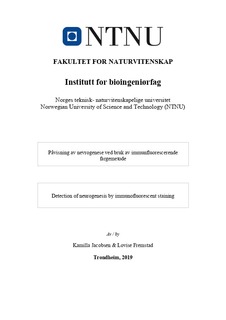| dc.contributor.advisor | Holt, Randi A. U. | |
| dc.contributor.advisor | Norevik, Cecilie S. | |
| dc.contributor.advisor | Tari, Atefe R. | |
| dc.contributor.author | Fremstad, Lovise | |
| dc.contributor.author | Jacobsen, Kamilla | |
| dc.date.accessioned | 2019-08-25T14:06:14Z | |
| dc.date.available | 2019-08-25T14:06:14Z | |
| dc.date.issued | 2019 | |
| dc.identifier.uri | http://hdl.handle.net/11250/2610804 | |
| dc.description.abstract | Om lag 50 millioner lider av Alzheimers sykdom (AS) på verdensbasis, og antallet er estimert å triple i løpet av år 2050. Alder er en av de største risikofaktorene for å utvikle AS. Ettersom levealderen øker og det per dags dato ikke finnes noen kur, er behovet for å finne behandling for nevrodegenerative sykdommer som AS stor. Det er fastslått at nydanning av nerveceller, også kalt nevrogenese, forekommer i hippocampus. Dette bidrar til å opprettholde hippocampus-avhengige kognitive ferdigheter. Nylige studier foreslår at eksponering av blodprodukter kan være en potensiell forebyggende behandling, ved å ha en mulig positiv innvirkning på nevrogenese i en aldrende rottehjerne.
En av forskningsgruppene på Cardiac Exercise Research Group (CERG) har et pågående prosjekt hvor friske, unge rotter gjennomgår et høy-intensitets treningsprogram over 6 uker. Videre blir blodet fra disse rottene injisert i en rottemodell som har utviklet et tidlig stadium av AS for å undersøke om nevrogenesen blir fremmet av behandlingen. Målet for prosjektet vårt var derfor å utvikle en tilpasset immunhistokjemisk protokoll for påvisning av nysyntetiserte nevroner, til bruk for laboratoriet på CERG.
Laboratoriearbeidet bestod av å snitte vev for deretter å velge ut snittene assosiert med hippocampus. Videre ble de utvalgte snittene farget med en metode basert på «BrdU assay for neurogenesis in rodents» av Wojtowicz & Kee, hentet fra Nature Protocols 2006 og «Immunofluorescent Protocol for BrdU» av Kitabayashi (2000), samt «BrdU staining and BrdU assay protocol» fra Abcam. Vi testet ulike parametere med målet om å optimalisere en protokoll tiltenkt bruk på laboratoriet til CERG.
Ingen av forsøkene på å optimalisere en BrdU protokoll resulterte i fluorescerende signal. Testresultatene ble derfor vurdert til negative.
Prosjektet hadde en begrenset tidsramme, og av denne grunn ble ikke BrdU protokollen fullstendig optimalisert. Det er derfor nødvendig med videre uttesting for å fullføre etableringen av den immunhistokjemiske fargemetoden med anti-BrdU for deteksjon av nysyntetiserte nevroner i en rottemodell for AS. | |
| dc.description.abstract | At present, a global prevalence of Alzheimer´s disease (AD) is reported to be as high as 50 million. By the year of 2050, this number is projected to triple. The largest risk factor for developing AD is increasing age. As human lifespan increases, and since no cure currently exists, the need for finding treatments for neurodegenerative diseases such as AD is obvious. It is well established that hippocampal neurogenesis contributes to maintain hippocampus-dependent cognitive abilities. According to recent studies, potential AD preventative treatments include exposure of blood products (plasma), which possibly have a positive impact on neurogenesis in an aging rat brain.
One of the research groups at Cardiac Exercise Research Group (CERG) has an ongoing project, where blood from healthy, young rats that have undergone a 6-week high intensity exercise-programme is injected to rats with a model of early stage AD to investigate whether this promotes neurogenesis. The aim of our project is therefore to develop a customized immunohistochemistry protocol for detection of newly synthesized neurons to be used at the laboratory at CERG.
The laboratory work consisted of tissue sectioning and thereafter selecting sections associated with the region of interest, the hippocampal region. Furthermore, the sections were stained using methods based on a protocol adapted from “BrdU assay for neurogenesis in rodents” by Wojtowicz & Kee from Nature Protocols 2006, “Immunofluorescent Protocol for BrdU”, by Kitabayashi (2000) and Abcam´s “BrdU staining and BrdU assay protocol”. In our project different parameters were tested with the aim of successfully optimizing a protocol intended for use in the laboratory at CERG.
None of the attempts to optimize a Bromodeoxyuridine (BrdU) staining protocol for neurogenesis detection resulted in a specific nuclear immunofluorescence signal, and the test results were stated as negative.
The BrdU staining protocol was not entirely optimized, as this was not achievable within the timeframe given for the project work. Therefore, it is necessary to perform further tests to complete the establishment of an immunohistochemical staining method with anti-BrdU for detection of newly synthesized neurons in a rat model for AD. | |
| dc.language | eng | |
| dc.publisher | NTNU | |
| dc.title | Påvisning av nevrogenese ved bruk av immunfluorescerende fargemetode | |
| dc.type | Bachelor thesis | |
